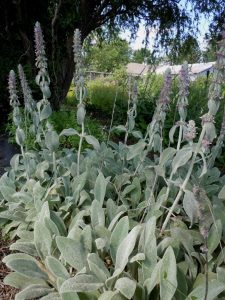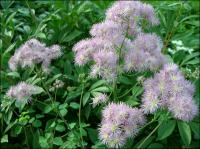Deer Resistant Plants
Showing 137–144 of 155 results
-
Stachys byzantina Lamb’s ears, Woolly betony, Wooly woundwort Z 4-8
Pale pink-lavender flowers on silver-gray spikes in summer with foliage as soft as a lamb’s ear.
Pale pink-lavender flowers on silver-gray spikes in summer with foliage as soft as a lamb’s ear.
Size: 12 x 12 spreading
Care: Full sun in moist well-drained to well-drained soil, low fertility
Native: Iran
Wildlife Value: Drought tolerant & deer resistant.Stachys is an old greek word meaning, “spike.” Stachys was believed to cure almost everything. Italians urged people to: “sell your coat and buy betony.” The common name “woundwort” describes the leaves’ function as bandages. Cultivated by George Washington at Mount Vernon.
-
Stachys minima syn. Stachys spathulata Dwarf betony Z 5-9
Atop a mound of spatula-shaped, crinkled leaves with scalloped edges rises a bounty of 4 to 5 inch tall spikes, each crowned with a hoard of tiny fuchsia-colored trumpets blowing their horns “look at me” in early to mid-summer.
OUT OF STOCK
Atop a mound of spatula-shaped, crinkled leaves with scalloped edges rises a bounty of 4 to 5 inch tall spikes, each crowned with a hoard of tiny fuchsia-colored trumpets blowing their horns “look at me” in early to mid-summer.
Size: 4-8" x 8-12" spreading slowly by rhizomes
Care: sun to part shade in moist well-drained soil
Native: South Africa
Wildlife Value: Deer resistant. Attracts small bees and butterfliesEnglish adventurer and naturalist William John Burchell (1781-1863) scoured South Africa from 1803 to 1815 collecting more than 50,000 specimens packed in 48 crates. In places unexplored he found insects, animals, fish and unknown plants, this being one. Although he published two volumes of his exploration, he did not finish the last, third volume, leaving another to write the botany. Premier English botanist George Bentham (1800-1884) took up the task authoring Labiatarum Genera et Species, published in 1834. He wrote the first published description and named this tiny plant with outsized charm.
-
Stachys officinalis syn. Betonica officinalis syn. Stachys betonica Bishop’s wort, Betony Z 4-8
Showy reddish-purple spikes of two-lipped tubes in May and June
Showy reddish-purple spikes of two-lipped tubes in May and June
Size: 18-24” x 12-18” slowly spreading
Care: sun in moist well-drained soil
Native: Europe and Asia
Wildlife Value: deer & walnut tolerant, attracts hummingbirdsOnce one of the most honored herbal medicines. Medicines were good if they had “as many virtues as Betony.” John Sauer, Colonial herbalist claimed “there is no illness brought on by cold in which Betony cannot be administered effectively.”
-
Symphoricarpos albus Snowberry Z 3-7
Small pink bell-shaped flowers turn into copious clusters of round, white berries, like miniature snowballs, grace this shrub from late summer through winter.
OUT OF STOCK
Small pink bell-shaped flowers turn into copious clusters of round, white berries, like miniature snowballs, grace this shrub from late summer through winter.
Size: 3-6’ x 3-6’
Care: sun to part shade in moist well-drained to well-drained soil
Native: Canada east to west coasts; US all states north from Virginia to California. Wisconsin native.
Wildlife Value: deer tolerant, attracts numerous birds including Hummingbirds, Towhees, Grouses, Robins, and Waxwings for nesting and food, although the fruit is poison to humans. Bees flock to the flowers’ pollen. Host for caterpillars of the Snowberry Sphinx moth and Snowberry Clearwing moth.Pauites of Oregon constructed cradle boards with the wood, sharpened the stem for digging tool and used its branches in a game of dice. The Nez Perce boiled sticks in water then used to remedy fevers, and encircled its branches around cradleboards to protect babies from ghosts. Flathead cured injured eyes with juice for the fruit and made a paste of its fruit, bark and leaves to remedy skin ailments and burns. For the Blackfoot the smoke from burning twigs blackened newly made pipes. Sioux made a diauretic from the fruit. Ojibwa speeded up convalescence for new mothers after giving birth with water infused with this. Shoshone made arrows from shoots for small birds. Collected for botany before 1753. Also collected on Lewis and Clark Expedition along the Missouri River west of Council Bluffs.
**LISTED AS OUT OF STOCK BECAUSE WE DO NOT SHIP THIS ITEM. IT IS AVAILABLE FOR PURCHASE AT OUR RETAIL LOCATION.
-
Syneilesis aconitifolia syn. Senecio aconitifolia Shredded umbrella plant; in China, tu er san Z 3-8
Grown for its excellent foliage in dry shade. I guess “Shredded umbrella” best describes this plant with thin, dissected leaves atop a leafless stem. drooping in a rounded shape, like an umbrella, but it wouldn’t shelter from rain. Pale pink to white flowers in early to mid-summer.
OUT OF STOCK
Grown for its excellent foliage in dry shade. “Shredded umbrella” best describes this plant with thin, dissected leaves atop a leafless stem. Drooping in a rounded shape, like an umbrella, but it wouldn’t shelter from rain. Pale pink to white flowers in early to mid-summer.
Size: 3’ x 2’, spreads slowly by rhizomes
Care: part to full shade in moist, well-drained to well-drained soil. Drought tolerant once established.
Native: China, Korea & Japan and eastern Russia
Wildlife Value: Attracts bees, butterflies and birds. Deer and rabbit resistant.Described in Flora of China in 1833. Chinese used the whole plant for medicine, to relax and activate the tendons, alleviate pain around the waist and legs, and to treat most any injuries.
-
Tanacetum niveum Silver tansy, Snow tansy Z 5-9
Profusion of small classic daisies May-July atop fragrant silver foliage. Cut back for rebloom. Let the seeds drop for more plants next year. If you cut them back after the 1st flowering they will rebloom for most of the summer and fall.
Profusion of small classic daisies May-July atop fragrant silver foliage. Cut back for rebloom. Let the seeds drop for more plants next year. If you cut them back after the 1st flowering they will rebloom for most of the summer and fall.
Size: 2’ x 3’
Care: sun in moist well drained soil
Native: central & southern EuropeNamed by Carl Heinrich Schultz (1805-1867)
-
Teucrium hircanicum syn. T hyrcanicum Iranian germander, Purple Tails, Wood Sage Z 5-8
Loads of deep purple erect spikes from mid-summer through fall making this subshrub one of the best
Loads of deep purple erect spikes from mid-summer through fall making this subshrub one of the best
Size: 18-24” x 24”
Care: sun in moist well-drained to well-drained soil
Native: Caucausus and Iran
Wildlife Value: attract butterflies, deer resistantDescribed and named by 1753
-
Thalictrum aquilegifolium Meadowrue, Feathered columbine Z 5-9
Delicate lavender to pink panicles of showy stamens in early summer
Delicate lavender to pink panicles of showy stamens in early summer
Size: 36" x 18"
Care: Sun to part shade in moist humusy soil
Native: Europe and North Asia
Wildlife Value: attracts Black swallowtail butterflyThalictrum is from Greek meaning “to flourish” or “look green.” In 1629 Parkinson, apothecary to James I and later, botanist to Charles I, called this “Tufted columbine” a descriptive name, the flowers are tufted, and the leaves resemble those of a columbine. Ancient Romans used it to cure ulcers, the plague and “the Faundife.” Romans stuffed children’s’ pillows with the flowers to bring them wealth. Liberty Hyde Bailey described Thalictrum aquilegifolium as: “A good garden plant and frequently planted,”(1933). Cultivated in U.S. since 1700’s.






